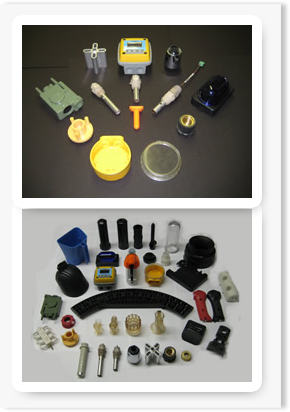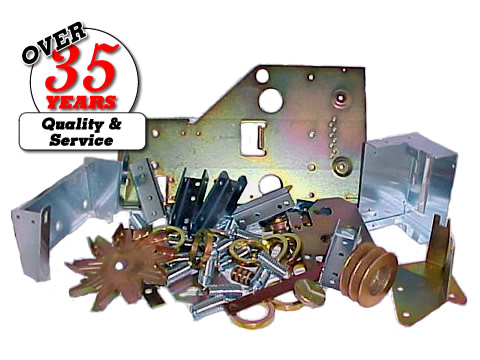
- Medical
- Irrigation
- Agricultural & Farming
- Equipment
- General industrial
- Aerospace
- Automotive and defense
- Research & Lab equipments
- Electronics
- Construction
- Communications
- House wares & Consumer Products
- Cosmetics and Personal Care Products
Value Added Secondary Services
In addition to continuously improving our molding capabilities, Hi-Rel Plastics & Molding, Inc. have years of experience in proven advanced molding technologies like

Metal Finishing and Plating
We want to provide your parts finished, per print and that includes finishing the
metal.
Standard Metal Plating
Tin
• Bright (Mil-T-10727, Type 1)
• Dull electro tin
Tin/Lead
• 60/40
• 63/37 (eutectic)
• 90/10
Copper
Nickel
• Electroless (Mil-C26074)
• Electrolytic (Mil-QQN-290)
Precious (noble) Metal Plating
Gold
Hard gold (Mil-G45204 Types 1&2, Grades B&C)
Soft gold (Mil-G45204 Type 3, Grade A)
Silver
• Matte finish (Type 1)
• Bright finish (Type 3)
Platinum
Palladium
Rhodium
Other Metal Finishing Options
• Anodizing
• Blackening
• Black oxide on copper and brass (Mil-F-495)
• Black zinc on steel (Mil-QQZ-325)
• Electropolishing
• Painting
• Passivation
• Selective Plating
• Teflon
• Tumbling
And many more! Contact Sales.
Metal Finishing & Plating Descriptions:
Tin:
Electro-tin plating is used for excellent solderability and corrosion resistance.
Tin/Lead:
Electro-tin plating is used for excellent solderability and corrosion resistance. This option is
NOT RoHS compliant.
Zinc Plating
Zinc plating is the process that involves electrolytic application of zinc to metal by immersing
clean steel parts into a zinc salt solution and applying electric current into it. This
immersion produces zinc coatings that prevent oxidation of the protected metal. Zinc coating
acts as a barrier and as a sacrificial anode when this barrier is damaged. Zinc is the best ally
of steel to combat its natural enemy: corrosion.
Nickel:
Nickel plating is generally used to improve corrosion and wear resistance of the underlying base
metal. Electroless Nickel ( Mil-C-26074) is good on flat or gently formed parts. Electroplated
Nickel (QQ-N-290) is also available. Both types of nickel plating are not recommended on parts
with sharp, formed features as the brittle plating will crack when the part is formed.
Appearance of nickel can be similar to stainless steel in color, or an almost white, dull-grey
color. Nickel plating is magnetic. Specify thicknesses ranging from 100u” up to 600u” and
up.
Gold:
Gold plating is used in electronic parts where electrical conductivity and high corrosion
resistance are required. Under Mil-G-45204 are Types I and II, grades B & C are known as hard
gold Type III, grade A is known as soft gold (best used for wire bonding). If all you need is a
gold flash, only 3 to 5 millionths of an inch of Type I, grade B is needed. Specify thickness
from 10u” up to 100u”.
Silver:
Silver plating such as matte finish silver (Type I) and bright finish silver (Type III) are
sometimes used where high electrical conductivity and excellent solderability (but decreases
with age) are required. Has good corrosion resistance, depending on base metal. QQ-S-365.
Specify thicknesses from 100u” up to 1000u”.
Anodizing:
Anodizing, an electrolytic process, converts aluminum surfaces to aluminum oxide. A hard
coating, and resistant to corrosion. The process changes the molecular structure of the metal
surface, giving it a thin, protective film. Anodized finishes are usually colorless, but can be
dyed in a variety of colors. Aluminum is often anodized, as is titanium, magnesium and
tantalum.
Blackening (Black Oxide):
For ferrous metals, a black, uniform coating commonly used for decorative purposes. Can provide
very limited corrosion protection. Used to reduce light reflection, the more popular types of
blackening are black oxide on copper and brass (Mil-F-495) and black zinc on steel
(QQZ-325).
Electropolishing:
Electropolishing is widely used to provide parts a shiny and smooth surface, this process
removes a few layers of atoms from a part (typically .0002″-.0005″), smoothing the surfaces and
rounding the edges.
Painting:
Hi-Rel Plastics & Molding, Inc. can fully or selectively paint your part. If you have ½ etch
features, we can paint and fill. If you have a specific paint color in mind, please provide the
Pantone number.
Passivation:
Passivation is primarily used for cleaning and descaling stainless steel parts. While cleaning
provides an enhanced appearance to the metal, it also ensures maximum corrosion resistance and
prevents product contamination. MIL-S-5002.
The stainless steel passivation process removes "free iron" contamination left behind on the
surface of the stainless steel which result in premature corrosion. In addition, the passivation
process facilitates the formation of a thin, transparent oxide film that protects the stainless
steel from selective oxidation (corrosion).
Selective plating:
Hi-Rel Plastics & Molding, Inc. can etch your part, then selectively mask and plate onto your
part. Works will most types of plating (electrolytic, electroless).
Tumbling:
Tumbling is used to give parts a smoother surface area, to clean, and to break sharp edges.
Parts are mixed in a vibratory tumbler with a selected media.


